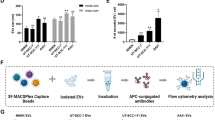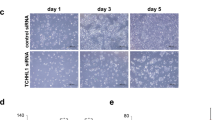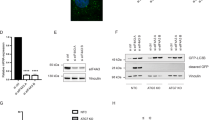Abstract
Enhancing factor (EF), a growth factor modulator, is the mouse homologue of human secretory group II phospholipase A2. EF exhibits growth-promoting activity in vitro, in the presence of epidermal growth factor, and also brings about phenotypic transformation of normal cells. In order to ascertain the role of EF in vivo, a human keratin-14 promoter was used to drive the expression of EF ectopically to squamous epithelial cells. The founder mouse and its progeny showed abnormal whiskers and a scaly, beaded tail. In these mice, keratinization pattern of the epidermis was disturbed and parakeratosis and acanthosis were noted. The transgenic mice, TgK14-EF, expressed EF in the suprabasal layers of tail epidermis as well as in the epithelial cells of hair follicle and sebaceous glands of skin. Expression of EF along with hyperplasia was also observed in other squamous epithelia such as buccal mucosa, tongue and oesophagus. TgK14-EF mice homozygous for the transgene showed delayed and scanty hair growth although the mice were healthy and fertile. The hemizygous TgK14-EF mice were sensitive to a two-stage chemical carcinogenesis and developed a higher number of papillomas than their normal littermates over the course of the experiment. The conversion rate of papilloma to carcinoma was two fold higher in the transgenic mice.
This is a preview of subscription content, access via your institution
Access options
Subscribe to this journal
Receive 50 print issues and online access
$259.00 per year
only $5.18 per issue
Buy this article
- Purchase on SpringerLink
- Instant access to full article PDF
Prices may be subject to local taxes which are calculated during checkout





Similar content being viewed by others
References
Cohen S and Elliott GA . (1963). J. Invest. Dermatol., 40, 1–5.
Cormier RT, Hong K, Halberg RB, Hawkins TL, Richardson P, Mulherkar R, Dove WF and Lander ES . (1997). Nat. Genet., 17, 88–91.
Deo MG, Mulherkar R and Mane SM . (1983). Ind. J. Biochem. Biophys., 20, 228–230.
Gelb MH, Valentin E, Ghomashchi F, Lazdunski M and Lambeau G . (2000). J. Biol. Chem., 275, 39823–39826.
Grass DS, Felkner RH, Chiang M, Wallace RE, Nevalainen TJ, Bennett CF and Swanson ME . (1996). J. Clin. Invest., 97, 2233–2241.
Green MR, Basketter DA, Couchman JR and Rees DA . (1983). Dev. Biol., 100, 506–512.
Jiang CK, Epstein HS, Tomic M, Freedberg IM and Blumenberg M . (1991). J. Invest. Dermatol., 96, 162–167.
Kadam S and Mulherkar R . (1999). Biochem. J., 340, 237–243.
Kaiser E, Chiba P and Zaky K . (1990). Clin Biochem., 23, 349–370.
Kennedy BP, Payette P, Mudgett J, Vadas P, Pruzanski W, Kwaan M, Tang C, Rancourt DE and Cromlish WA . (1995). J. Biol. Chem., 270, 22378–22385.
Kiguchi K, Bol D, Carbajal S, Beltran L, Moats S, Chan K, Jorcano J and DiGiovanni J . (2000). Oncogene, 19, 4243–4254.
Lavker RM, Miller S, Wilson C, Cotsarelis G, Wei ZG, Yang JS and Sun TT . (1993). J. Invest. Dermatol., 101, 16S–26S.
Morris RJ, Fischer SM and Slaga TJ . (1986). Cancer Res., 46, 3061–3066.
Mulherkar R and Deo MG . (1986). J. Cell. Physiol., 127, 183–188.
Mulherkar R, Desai SJ, Rao RS, Wagle AS and Deo MG . (1991). Histochemistry, 96, 367–370.
Mulherkar R, Rao R, Rao L, Patki V, Chauhan VS and Deo MG . (1993a). FEBS Lett., 317, 263–266.
Mulherkar R, Rao RS, Wagle AS, Patki V and Deo MG . (1993b). Biochem. Biophys. Res. Comm., 195, 1254–1263.
Murakami MY, Nakatani Y, Atsumi G, Inoue K and Kudo I . (1997). Crit. Rev. Immunol., 17, 225–283.
Murillas R, Larcher F, Conti CJ, Santos M, Ullrich A and Jorcano JL . (1995). EMBO J., 14, 5216–5223.
Oshima H, Rochat A, Kedzia C, Kobayashi K and Barrandon Y . (2001). Cell, 104, 233–245.
Roop DR, Krieg TM, Mehrel T, Cheng CK and Yuspa SH . (1988). Cancer Res., 48, 3245–3252.
Shibata MA, Ward JM, Green JE and Merlino G . (1997). Mol Carcinogen, 18, 160–170.
Taylor G, Lehrer MS, Jensen PJ, Sun T and Lavker R . (2000). Cell, 102, 451–461.
Vassar R and Fuchs E . (1991). Genes Dev., 5, 714–727.
Vassar R, Rosenberg M, Ross S, Tyner A and Fuchs E . (1989). Proc. Natl. Acad. Sci. USA, 86, 1563–1567.
Wagle AS, Desai SJ and Deo MG . (1989). Cell Biol. Int. Rep., 13, 309–311.
Xie W, Chow LT, Wu X, Chin E, Paterson AJ and Kudlow JE . (1998). Cell Growth Differ., 9, 313–325.
Acknowledgements
We thank Dr AS Wagle and Dr RA Bhisey for their helpful discussions and comments on the manuscript; and Mr JK Rane, Mr AV Jadhav, Mr PS Chavan, Mr VM Sakpal and Mr ML Jagtap for their excellent technical assistance. This work was funded partially by the Department of Biotechnology (Grant # BT/R&D/09/034/94), New Delhi. BMK was a recipient of the UGC fellowship, Government of India.
Author information
Authors and Affiliations
Corresponding author
Rights and permissions
About this article
Cite this article
Mulherkar, R., Kirtane, B., Ramchandani, A. et al. Expression of enhancing factor/phospholipase A2 in skin results in abnormal epidermis and increased sensitivity to chemical carcinogenesis. Oncogene 22, 1936–1944 (2003). https://doi.org/10.1038/sj.onc.1206229
Received:
Revised:
Accepted:
Published:
Issue date:
DOI: https://doi.org/10.1038/sj.onc.1206229
Keywords
This article is cited by
-
Phospholipase A2 in skin biology: new insights from gene-manipulated mice and lipidomics
Inflammation and Regeneration (2018)
-
Secretory phospholipase A2-IIA overexpressing mice exhibit cyclic alopecia mediated through aberrant hair shaft differentiation and impaired wound healing response
Scientific Reports (2017)
-
Genetically modified laboratory mice with sebaceous glands abnormalities
Cellular and Molecular Life Sciences (2016)
-
Chk1 is essential for chemical carcinogen-induced mouse skin tumorigenesis
Oncogene (2012)



